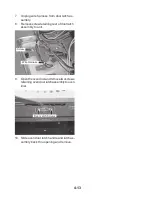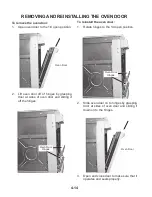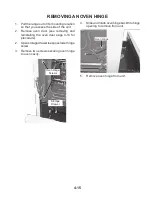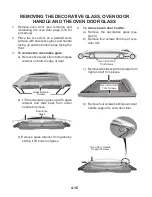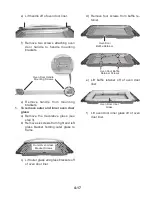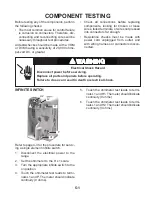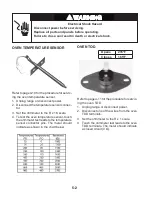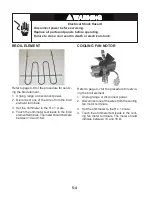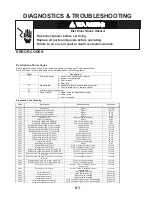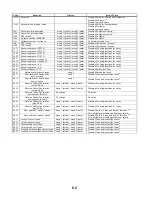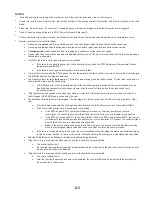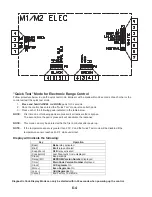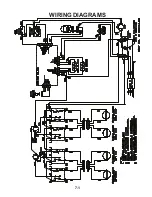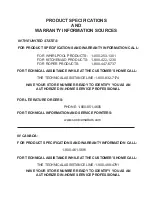
6-3
NOTES:
1
“Action Taken” applies as long as the condition exists. If the condition goes away, the control recovers.
2
If there is a cook function or timer active, the function continues. The user cannot edit the function, and [Cancel] will canc el the cook
mode.
3
Flash rate: 0.2 seconds on, 0.1 second off. Pressing any key will clear the display until the fault clears and is re-triggered.
4
“Action Taken” applies until there is a POR (Power On Reset [“hard reset”]).
5
If the control believes the door is locked, it will attempt to unlock it when the function cancels and the cavity temperature cools.
6
Special conditions for latch faults (9dxx):
•
A known good
unlock
position is defined as when the unlock switch reads closed and lock switch reads open.
•
A known good
lock
position is defined as when the unlock switch reads open and lock switch reads closed.
•
A
faulted switch
means the switch input is reading an invalid state, neither open nor closed.
•
Once a latch fault occurs, latch movement is disabled until there is a POR. An error tone w ill sound if a function requiring a
faulted latch is attempted.
•
If at POR, the latch is not at a known good unlock position:
•
If the latch is at a good lock position, it will attempt to unlock when the RTD (Resistance Temperature Device)
temperature is below 400°F.
•
If the latch is not at a good lock position, the control will fault.
•
If a latch fault occurs while the RTD is above the lock temperature, the latch will not try to move, but the fault is still logged
to EEPROM after the first stage of detection.
•
The Display column for latch faults applies 1) If the latch was moving when the fault occurred; 2) If the latch is already in a
known locked state when the fault occurs.
•
LOCK flashes after a fault is detected and until the unlocked position is achieved. The unlock position may be
identified by a successful unlock switch closure, or as the result of timing when the unlock switch is not
functioning properly.
•
If the last known good position was unlock (e.g. baking, or idle) and a latch fault occurs, the motor is never moved. The
fault is logged to EEPROM and is not seen by the user.
•
The detection for latch faults is in two stages. The first stage is to let the control recover without moving the latch. After
this:
•
If the latch was previously at a known good unlock position, the latch will not move and the control will fault.
•
If the control was previously in a known good lock position:
•
If the RTD is below 400°F, the latch will attempt to recover to it’s proper position (up to three
revolutions). If it cannot, the control will fault and the latch will move to a calculated unlock position.
•
If the RTD is at or above 400°F, the control will fault. When the RTD cools to below 400°F, the control
will attempt to recover to a good unlock position (up to three revolution). If it cannot, the control will fault
and the latch will move to a calculated unlock position.
•
Note:
If the unlock position cannot be found, this may result in a second fault, the first fault occurring
when the latch request was locked, and the second when the latch request is unlocked.
•
If the latch is moving when the fault occurs, the control will bypass the first stage of detection and immediately try
to find it’s proper position. If it cannot, the control will fault and the latch will move to a calculated unlock position.
•
Affected DLBs (Double Line Breaks) and loads are disabled during detection.
•
If the control is in a known good unlock position and the lock switch becomes faulted:
•
The control will not fault.
•
If a function requiring latch movement is attempted while the lock switch is faulted, the control will sound an error
tone and the function will be disabled.
•
If the control is in a known good lock position and the unlock switch becomes faulted:
•
The control will not fault.
•
After the function is canceled and unlock is attempted, the control will attempt to unlock the latch according to
the procedures in these notes.
Summary of Contents for RY160LXTQ
Page 26: ...2 18 NOTES ...
Page 52: ...5 6 NOTES ...
Page 58: ...6 6 NOTES ...
Page 59: ...7 1 WIRING DIAGRAMS ...
Page 60: ...7 2 ...
Page 62: ......

